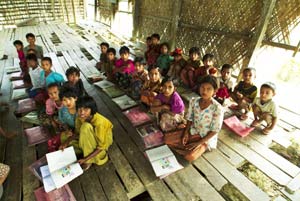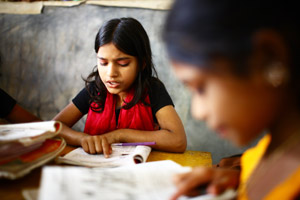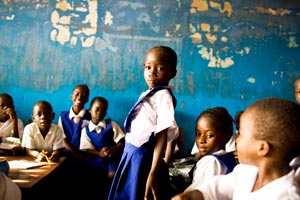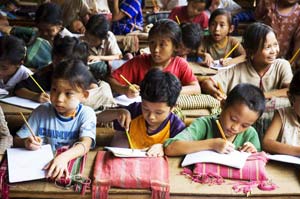the process of teaching or learning, especially in a school or college, or the knowledge that you get from this:receive an education
Function of education
Before public schools emerged in American society, children were taught at home or through a community-based organization like a religious group. Children were taught necessary skills, core subjects (like reading and writing), and values, specifically Puritan values. Public schools began to appear, but were costly, and it wasn't until the 19th and 20th centuries that laws were put in place to require free, public education for all children.
With the emergence of government-regulated schools came government-regulated education. This meant a shift from religious-based studies, to a broader approach which emphasized making children into functioning members of society.
When deciding how to narrow down all of the world's information, it is important to ask, What is the role of school in society? Schools serve the purpose of transmitting knowledge so that students have a basic understanding of the information and skills they need. However, the role of school is much greater than just basic knowledge. The functions of education are constantly evolving to match the needs of society and include learning about different topics, preparing for college or careers, and broadening one's cultural knowledge. These functions are sometimes overt and considered to be a manifest function; they appear in the curriculum and are intended by teachers and schools. Other times, the functions are unintended and considered to be a latent function; they appear as a byproduct of the intended functions.
With the emergence of government-regulated schools came government-regulated education. This meant a shift from religious-based studies, to a broader approach which emphasized making children into functioning members of society.
When deciding how to narrow down all of the world's information, it is important to ask, What is the role of school in society? Schools serve the purpose of transmitting knowledge so that students have a basic understanding of the information and skills they need. However, the role of school is much greater than just basic knowledge. The functions of education are constantly evolving to match the needs of society and include learning about different topics, preparing for college or careers, and broadening one's cultural knowledge. These functions are sometimes overt and considered to be a manifest function; they appear in the curriculum and are intended by teachers and schools. Other times, the functions are unintended and considered to be a latent function; they appear as a byproduct of the intended functions.
Socialization
Socialization is a process of learning; through this lifelong process, people learn how to become functioning members of society. Individuals attain a personal identity by learning knowledge, language, and social skills that will help them function well with others. Students at all ages are constantly rewarded or punished due to their performance of these skills.
Examples of socialization:
- Rules and expectations. Rules and expectations are not always innate. The social contract theory is a model which explains how societies and communities create rules or expectations based on agreed-upon morals or values.
- In a preschool or kindergarten classroom, students are taught how to share and be kind with others. Many American schools teach the Golden Rule and reward children who display acts of kindness or take turns.
- Following schedules. Most American schools following a strict schedule. Students are expected to be in their first class by a specific time and must get to their next classes before the bell rings. When they miss a class or are tardy, they risk consequences like detention.
- Submitting to authority. In a traditional classroom, desks are placed in straight lines facing the teacher, students must raise their hand to speak, and they need permission to leave the room.
Concept of Education
The concept of education has changed from a process of transferring knowledge from the teacher to the student (a ‘banking’ system2), to learning as the construction of knowledge by the student (studentcentred). Education involves the acquisition of knowledge, skills, beliefs, values and the culture of a given society. The contemporary Western un- derstanding of education is as a life-long process of learning that is facilitated in organised ways that include both formal (such as schools and universities) and non-formal settings (such as community environments and the media), as well as in unorganised ways or informal places. However, it should be noted that education is more than vocational training be- cause it is not confined to skills development.
Education is always political and ideological. That is because educational practices do not take place in a vacuum. They reflect the ideologies or worldviews of the dominant groups of a society and are shaped by their values. Education that involves the construction and dissemination of knowledge and values through dialogue is an open system because it allows for the freedom to question, negotiate and relate one’s personal experiences to the learned concepts. On the other hand, a closed system of education is when knowledge is transmitted to learners through practices such as rote learning, which implies indoctrination because there is no opportunity to question or challenge ideas. Although all education is embedded with ideology, the issue here is with violent extremist ideologies as opposed to democratic worldviews. However, from a security perspective, education is like a double-edged sword: it can be used to counter violent extremism as well as promote extremist ideologies.
Formal and Informal Education
Education is not solely concerned with the basic academic concepts that a student learns in the classroom. Societies also educate their children, outside of the school system, in matters of everyday practical living. These two types of learning are referred to as formal education and informal education.
Formal education describes the learning of academic facts and concepts through a structured, programmatic curriculum. Arising from the tutelage of ancient Greek thinkers, centuries of scholars have examined topics through logical, systematic methods of learning. Education in earlier times was only available to the higher classes; they had the means for access to scholarly materials, plus the luxury of leisure time that could be used for learning. The Industrial Revolution, urbanization, the development of state-sponsored, publicly-funded institutions, and other social changes made education more accessible to the general population. Later, many families in the emerging middle class found new opportunities for schooling.

The modern U.S. educational system is the result of this progression. Today, basic education is considered a right and responsibility for all citizens. The United Nations outlines education as a basic human right in its Universal Declaration of Human Rights (Citation F), arguing that education must be free and universally-accessible.
Expectations of this system focus on formal education, with curricula and testing designed to ensure that students learn the facts and concepts that society believes are basic knowledge.
In contrast, informal education describes learning about cultural values, norms, and expected behaviors through societal participation. This type of learning occurs in family homes, community spaces, and through the education system. Our earliest learning experiences generally happen via parents, relatives, and others in our community. Through informal education, we learn how to dress for different occasions, how to perform regular life routines like shopping for and preparing food, and how to keep our bodies clean.
Overview of the right to education worldwide
Most affected regions.
As a result of poverty and marginalization, more than 72 million children around the world remain unschooled.
Sub-Saharan Africa is the most affected area with over 32 million children of primary school age remaining uneducated. Central and Eastern Asia, as well as the Pacific, are also severely affected by this problem with more than 27 million uneducated children.

Additionally, these regions must also solve continuing problems of educational poverty (a child in education for less than 4 years) and extreme educational poverty (a child in education for less than 2 years).
Essentially this concerns Sub-Saharan Africa where more than half of children receive an education for less than 4 years. In certain countries, such as Somalia and Burkina Faso, more than 50% of children receive an education for a period less than 2 years.
The lack of schooling and poor education have negative effects on the population and country. The children leave school without having acquired the basics, which greatly impedes the social and economic development of these countries
Universal Access to Education
Access to Education
Another global concern in education is universal access.
This term refers to people’s equal ability to participate in an education system. As called for by the UN’s Universal Declaration on Human Rights, all individuals around the world are entitled to a free education at the primary level, both to develop skills and to become more functional members of society through learning tolerance and a respect for freedoms.
However, on a practical global level, educational access might be more difficult than the United Nations hoped for when first drafting the Declaration on Human Rights in 1948, particularly for certain groups based on class or gender. This was the case in much of the United States–even in the mid-twentieth century–though substantial progress has been made since that time
1.Examine the perspective of conflict theory on education examine the feminist theory on education
Conflict Theory
Conflict theorists do not believe that public schools reduce social inequality through providing equal opportunity. Rather, they believe that the educational system reinforces and perpetuates social inequalities that arise from differences in class, gender, race, and ethnicity. Where functionalists see education as serving a beneficial role, conflict theorists view it more negatively. To them, educational systems preserve the status quo and push people of lower status into obedience, which keeps them socioeconomically disadvantaged.

The fulfillment of one’s education is closely linked to social class. Students of low socioeconomic status are generally not afforded the same opportunities as students of higher status, no matter how great their academic ability or desire to learn. Picture a student from a working-class home who wants to do well in school. On a Monday, he’s assigned a paper that’s due Friday. Monday evening, he has to babysit his younger sister while his divorced mother works. Tuesday and Wednesday, he works stocking shelves after school until 10:00 p.m. By Thursday, the only day he might have available to work on that assignment, he’s so exhausted he can’t bring himself to start the paper. His mother, though she’d like to help him, is so tired herself that she isn’t able to give him the encouragement or support he needs. And since English is her second language, she has difficulty with some of his educational materials. They also lack a computer and printer at home, which most of his classmates have, so they rely on the public library or school system for access to technology. As this story shows, many students from working-class families have to contend with helping out at home, contributing financially to the family, poor study environments, and a lack of family support. This is a difficult match with education systems that adhere to a traditional curriculum that is more easily understood and completed by students of higher social classes.
Such a situation leads to social class reproduction, extensively studied by French sociologist Pierre Bourdieu. He researched how cultural capital, or cultural knowledge that serves as (metaphorical) currency that helps us navigate a culture, alters the experiences and opportunities available to French students from different social classes. Members of the upper and middle classes have more cultural capital than do families of lower-class status. As a result, the educational system maintains a cycle in which the dominant culture’s values are rewarded and thus generationally reproduced. Instruction and tests cater to the dominant culture and leave others struggling to identify with values and competencies outside their social class. For example, there has been a great deal of discussion over what standardized tests such as the SAT truly measure. Many argue that the tests group students by cultural ability rather than by natural intelligence. For example, a question on the comprehensive reading section of the SAT inquires about a painting at an art museum. For a student who has not experienced art museums regularly, this question poses greater difficulty than it does for a student who grew up going to cultural events such as art exhibitions. Such mechanisms in public education reinforce and perpetuate inequalities.
Inequality between girls and boys: the education of girls in jeopardy
Today, it is girls who have the least access to education. They make up more than 54% of the non-schooled population in the world.
This problem occurs most frequently in the Arab States, in central Asia and in Southern and Western Asia and is principally explained by the cultural and traditional privileged treatment given to males. Girls are destined to work in the family home, whereas boys are entitled to receive an education.

In sub-Saharan Africa, over 12 million girls are at risk of never receiving an education. In Yemen, it is more than 80% of girls who will never have the opportunity to go to school. Even more alarming, certain countries such as Afghanistan or Somalia make no effort to reduce the gap between girls and boys with regard to education.
Although many developing countries may congratulate themselves on dramatically reducing inequality between girls and boys in education, a lot of effort is still needed in order to achieve a universal primary education.
Causes of lack of education
Marginalisation and poverty
For many children who still do not have access to education, it is notable because of persisting inequality and marginalization.
In developing and developed countries alike, children do not have access to basic education because of inequalities that originate in sex, health and cultural identity (ethnic origin, language, religion). These children find themselves on the margins of the education system and do not benefit from learning that is vital to their intellectual and social development.
 Factors linked to poverty such as unemployment, illness and the illiteracy of parents, multiply the risk of non-schooling and the drop-out rate of a child by 2.
Factors linked to poverty such as unemployment, illness and the illiteracy of parents, multiply the risk of non-schooling and the drop-out rate of a child by 2.
Undeniably, many children from disadvantaged backgrounds are forced to abandon their education due to health problems related to malnutrition or in order to work and provide support for the family.
Financial deficit of developing countries
Universal primary education is a major issue and a sizeable problem for many states.
 Many emerging countries do not appropriate the financial resources necessary to create schools, provide schooling materials, nor recruit and train teachers. Funds pledged by the international community are generally not sufficient enough to allow countries to establish an education system for all children.
Many emerging countries do not appropriate the financial resources necessary to create schools, provide schooling materials, nor recruit and train teachers. Funds pledged by the international community are generally not sufficient enough to allow countries to establish an education system for all children.
Equally, a lack of financial resources has an effect on the quality of teaching. Teachers do not benefit from basic teacher training and schools, of which there are not enough, have oversized classes.
This overflow leads to classes where many different educational levels are forced together which does not allow each individual child to benefit from an education adapted to their needs and abilities. As a result, the drop-out rate and education failure remain high.






No comments:
Post a Comment